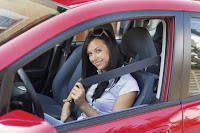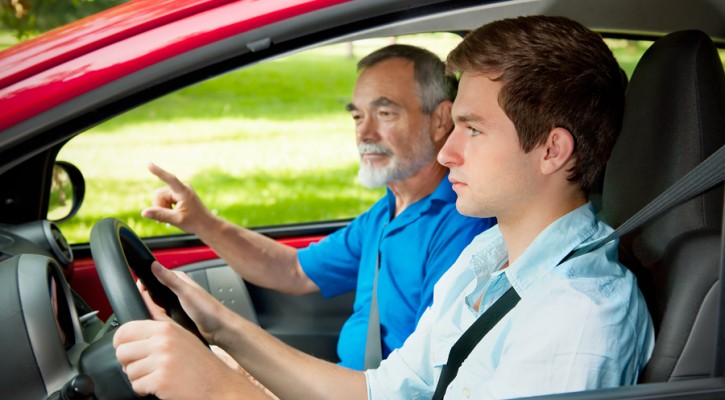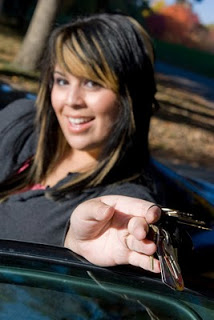Tag Archive: driver’s license

The Two-Step Process of Getting a Driver’s License
July 12, 2011
Though the process of getting a driver’s license may be simplified to a few steps, it does not necessarily mean that it is an easy in-and-out operation. One has to prepare well enough to pass both processes. The process that most states have is the knowledge test and the road skills test.
The first step is the knowledge test – this is for getting a permit.
Knowing the proper rules of the road is important when getting a license, so the first test consists of a written road rules and road signs test. Once the new driver has proved they understand the rules of the road, they can receive their learner’s permit to allow them to actually learn the skills needed behind the wheel of a car. The learner’s permit is designed to give new drivers a period (six months to a year), in which they can learn to drive under the close supervision of an experienced licensed driver (21 years of age or older). Once the new driver has developed their driving skills and gained enough experience, they should be ready to pass their driving skills or road test.
The second step, of course, is the driving skills test.
The behind the wheel road test is designed to test the basic driving skills that everyone needs to safely handle a motor vehicle. The road test is really quite simple. Although the road test is quite simple, approximately twenty five percent of new drivers fail in their first try. The examiner will give the new driver instructions to perform simple driving tasks such as parking, making an emergency stop, and a three-point-turn. The test isn’t designed to try to trick the driver and the test examiner will not ask the new driver to do anything that is illegal. If a minor mistake is made, the examiner will note it on the test form. If enough minor mistakes are made, usually adding up to 30 points, the driver will not pass. However, most of the failures are due to simple but costly mistakes. Mistakes such as failing to stop completely at a stop sign or hitting the cones while trying to park are grounds for an automatic failure. New drivers should practice these maneuvers over and over until they are second nature before attempting to pass the road test.
If you hold a valid license from one state and are trying to get a license in a new state, most states will allow a transfer of licenses without any additional tests but some states may require that a driver take either the written road test or both the written test and the road exam. Check the your state’s DMV driving manual and be prepared.
The key to getting a driver’s license is: study well, practice well and be patient.

Top 5 Hints for Passing the DMV Road Test
July 8, 2011
Picture the DMV road test: new driver in the driver’s seat, driving examiner-with-clipboard-in-hand sitting beside him in the passenger’s seat, giving instructions and with an ever-so-tight grip on a pen, taking notes. The driving exam can be grueling for new drivers who are worried about passing/failing — in other words, anxiety may become a factor in passing the driving road test.
Here are the top 5 hints for passing the driving road test:
1. Get lots of practice during your learner’s permit period. In most states, there is a required waiting period from getting a permit or intermediate license before a new driver is allowed to take the road test. This is essentially the state giving the new driver a chance to practice all the skills needed to pass the road test.
2. Obey signs/signals and avoid hitting the cones/curbs. Just because the driving examiner is writing notes on the examination form, that doesn’t mean that new driver has made a mistake. The examiner has to write down the good things as well as the bad. Minor mistakes are allowed but, if those minor mistakes add up to 30 points, you will fail the exam. There are several things that will cause you to automatically fail the exam. Failure to obey traffic signals/signs or hitting the cones/curbs while parking or conducting the three-point-turn are the most common reasons for an automatic failure. For the stopping part, there’s this 4-second-stop rule: to be sure that the car is in a complete halt, step down on the brakes and count to 4 to make sure that the car is totally stopped. For the parking segments, ask a family member (who is a valid license holder) to show you exactly how to park the right way and then practice it – – a lot! Practice the three-point-turn on a narrow street. Practice makes perfect.
3. Follow the examiner’s directions, while demonstrating the ability to make the right decisions. The driving examiner will not ask you any trick questions nor will he or she ask you to do anything that is illegal. Driving is tricky enough all by itself so they don’t have to try to trick you. The examiner will give you straight, simple instructions. Don’t look for the hidden meaning in the instructions; just do as he/she says. If you truly don’t understand the instruction, ask for clarification. It is better to ask than to try to guess and make a mistake. The stupid questions are the ones that don’t get asked.
4. Obey the state’s driving law. This one’s pretty simple, even with varying laws between states, there are still driving laws that are common to most. An example would be:
- Properly wearing a seatbelt before starting the vehicle.
- Properly yielding to other traffic when changing lanes.
- Properly giving a turn signal when turning, changing lanes, or turning into or backing out of a parking space
- Safe driving around school buses and school zones. (There will usually be signs to follow.)
- Knowing the meaning of a Yield sign. Slow and look for other traffic or pedestrians crossing your path and be prepared to stop if necessary. If the way is clear, keep going.
- Stop for pedestrians in a crosswalk.
- Don’t follow too close, maintain a two to three-second following distance.
5. Make sure you have all of the documents that will be needed. In order to take the road test, you will need a current vehicle registration slip that matches the dates on your tags. You will also need a current proof of insurance form. Both of these documents should be in the vehicle at all times. For proof of your ID to get a license, you will need a minimum of the following (check with your local DMV for a complete list):
- Birth Certificate with raised seal (or current passport)
- Social Security Card
- More than one proof of address, such as your parent’s electric or home insurance bills.
You will also need:
- A form signed by your parent of guardian showing you have received the necessary number of driving instruction hours for both day and night driving.
- Your parent’s written permission to receive a license (if under the age of 18).
- A certificate showing you have completed any state required driver education.
Master the Driving Maneuvers for the Road Test with a “Behind-the-Wheel” Online Simulator Course

Learn How to Drive on your Spring Break
February 25, 2011
Mention the word “Spring Break” and images of vacations and getaways come to mind. The reality is: not everyone gets to go on spring break. While this may dishearten some teens, the good news is: it’s a great time to learn how to drive!
Don’t exactly know where to start? Here are some suggestions on getting started on some spring break learning:
- Consider a visit to the DMV office. Different states have different requirements, so knowing these is a good start. Also, dropping by the DMV will allow you to get materials such as driver’s manuals to help aide your study. This can also be done online, with most states having their own official DMV site.
- Practice for your DMV written test online with a drivers license practice test. When completing the online course you’re guaranteed to pass your written test.
- If you’re already have your learners permit, get practice. Most states require a minimum of 50 hours, so running errands at home can sometimes be a way for new drivers to get experience driving, or completing required hours for driving. It’s the perfect time to familiarize one’s self with the vehicle, and properly operating it.
- Learn basic vehicle troubleshooting. Learn how to check the oil. Learn how to change a tire. Basically, learn the basics of being prepared for anything.
- Have fun. Imagine the surprise your friends will get when they find out you got started on learning how to drive. Driving is a lifelong skill that is both a convenience and a privilege, and there’s no better time to begin learning than when you have a break from your other responsibilities.
New Florida Driver’s License/ID Card Requirements for 2011
October 18, 2010
Florida enacted a new law on January 1, 2010, in order to comply with the federal Real ID Act, passed by Congress in 2005. Florida’s new law requires more positive proof of identification for anyone trying to get a license or a Florida ID card.
Lack of awareness of this law has resulted in a lot of customers at the DDL office who were turned away for lack of proper proof of identification. If you are planning to visit the DDL anytime soon, you will need to carry the required items of documentation with you if you need to:
- Apply for a new license or ID card
- Renew a license or ID card
- Change your name
- Change your address
- Replace a lost or stolen license
(If there are no changes, simple renewals can still be done online at: http://www.flhsmv.gov/html/online.html )
Primary Identification (proof of citizenship or legal presence). You need to provide ONE original or certified copy of any of the following:
- Certified United States birth certificate
- Valid United States Passport or Passport Card
- Consular Report of Birth Abroad
- Certificate of Naturalization, Form N-550 or Form N-570
- Certificate of Citizenship, Form N-560 or Form N-561
If a birth certificate is your chosen form of primary identification, then it must come from a government agency; hospital birth certificates are not accepted.
When necessary, marriage certificates, court orders, or divorce decrees must be provided to tie the name on the primary identification to the name the customer would like to place on the driver license or identification card.
Those born in Puerto Rico must present an new, updated birth certificate after September 30, 2010.
2. Proof of Social Security Number. Provide ONE original or certified copy of any of the following that proves your social security number tied to your full name.
- Social Security Card (must be an original and must be under name being applied for)
- W-2 Form
- Pay check/stub
- SSA-1099
- Any 1099 (not handwritten)
If an applicant currently does not have a social security number, one must bring a letter from the Social Security Administration indicating that the applicant was not issued one. In addition, secondary identification is required, which could be any of the following:
- A driver license from the District of Columbia, U.S. Territories or one from the 50 states
- School record starting date of birth, with the registrar’s signature
- Transcript of the birth record
- Baptism certificate, with the date of birth and place of baptism
- Family Bible record
- An insurance policy on the applicant’s name, which has been in place for at least 2 years
- United States military or military dependent identification card
- An identification card from the District of Columbia, U.S. Territories or one from the 50 states
- Florida license record or identification card record
- Selective Service Registration
- Florida Vehicle Registration Certificate (HSMV 83399, owner’s copy) or out-of-state registration certificate with name and date of birth
- Receipt copy of last Florida driver license issuance
- Immigration form I-571
- Federal form DD-214
- Marriage certificates
- Court order, which includes applicant’s legal name
- A Florida voter registration card, which was issued at least 3 months previously
- Parent consent form of minor, signed by the parent or legal guardian
- Government issued out-of-country passport, driver license or identification card
- Concealed weapons permit
Making the social security number a requirement reinforces the idea that social security is indeed, for social security.
3. Two Proofs of Residential Address. Bring TWO different documents that confirm the applicant’s residential address. It could by any TWO of the following:
- Deed, mortgage, rental/lease statement
- Florida Voter Registration Card
- Florida Vehicle Registration or Title
- Florida Boat Registration or Title
- TWO Proofs of residential address from a parent/legal guardian, along with a statement from a parent/legal guardian with whom the applicant resides with
- A utility hook up or work order dated within 60 days of application
- Automobile Payment Booklet
- Selective Service Card
- Medical/Health card with address
- Current homeowner’s insurance policy/bill
- Current automobile insurance policy/bill
- Transcript forms from current school year
- Unexpired professional license issued by government agency in the U.S.
- W-2 form or 1099 form
- Form DS2019, Certificate of Eligibility for Exchange Visitor (J-1) status
- A letter from a homeless shelter/transitional service provider/half-way house verifying that they receive mail for applicant
- Certificate of Address Form
- Utility bills
- Mail from financial institutions
- Mail from federal State, County or City government agencies
If an applicant’s current driver’s license has a P.O. Box under address, records must be updated that verify an applicant’s physical address. The address will be placed when the applicant next renews his/her license.
For more information, visit: http://www.gathergoget.com/

Five Tips After Teens Get Their Driver’s License
October 8, 2010
Once a teen gets their driver’s license, they will want to apply their new skill all the time. Some teens even volunteer to be the family driver and errand runner! (Depending on what age, and what kind of license they have.) But just because they have their license, the process of learning to drive isn’t over. Driver’s Education is continuing education, and there are still several things to tackle.
Here are a few tips for teens after they get their license:
- Encourage your parents to sign a parent-teen driving contract. If you don’t have one set up already, then show the initiative. Be the teen who demonstrates to their parents or guardian that they are willing to agree to some terms if they are going to help shoulder the responsibility of driving. It will save you both from any misunderstandings, over-reactions, and hard feelings, on the interpretations, expectations and consequences of your driving privilege.
- Practice, practice, practice. Though the teen may have his/her license, it’s easy for them and their parents to get complacent. While they may be skilled on how to drive, mastering and fine-tuning their skills only comes with experience. There’s still always much to master when it comes to driving, and asking a parent for help more not only increases that teen’s driving ability and safety, but also makes him/her bond closer with their parent. The evolution from learning to drive to becoming a safe and defensive driver is a long term progression. Parents need to stay engaged through out the process.
- Clear the dashboard. Like life, teens should remove unnecessary distractions when it comes to driving. Have disc-changers ready and music set before starting the vehicle. Keep cell phones in the glove compartment away from the driver’s reach. Also important, don’t be a chauffeur for friends. Having other teens in the car is a major form of distraction while driving, and research shows it increases the risk of a crash per passenger, exponentially.
- Clear your head someplace else. Driving isn’t a stress-reliever. When a teen has a problem, he/she shouldn’t use driving to clear his head. When a preoccupied mind does something that requires full attention, like driving, there is more likely to be mistakes. Having a talk with a friend, when you are not doing something else (like driving) is one of the best ways to cool one’s head. Driving when you are upset, angry or even extremely happy can be dangerous.
- Check the labels. Before taking any form of medication, even over-the-counter drugs, remember to check the labels. Some drugs have side-effects when taken, which may include dizziness or drowsiness. Either of which is never good for driving. Some medicines may give off false driving-under-the-influence signals. Make sure you are rested and in good health. Your physical health and well being can affect awareness, judgment and reaction time each important for safe driving.
Having your driver’s license does not mean you are good to go. In order to be a safe driver, there is still continuing education needed and defensive driving techniques to learn. Take advantage of this time to continue to be engaged in driver education as you gradually increase the opportunities and responsibilities driving brings.
